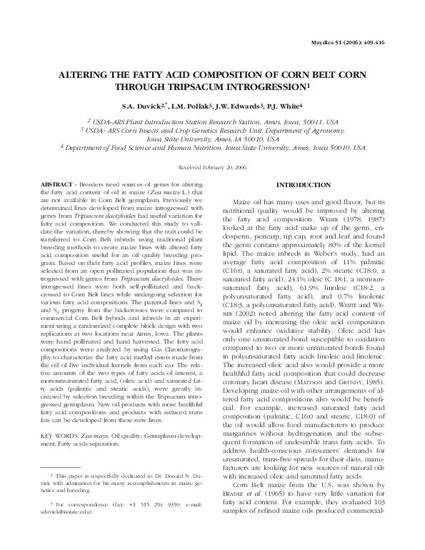
Article
Altering the fatty acid composition of Corn Belt corn through Tripsacum introgression
Maydica
Document Type
Article
Disciplines
Publication Date
1-1-2006
Abstract
Breeders need sources of genes for altering the fatty acid content of oil in maize (Zea maize L.) that are not available in Corn Belt germplasm. Previously we determined lines developed from maize introgressed with genes from Tripsacum dactyloides had useful variation for fatty acid composition. We conducted this study to validate the variation, thereby showing that the trait could be transferred to Corn Belt inbreds using traditional plant breeding methods to create maize lines with altered fatty acid composition useful for an oil quality breeding program. Based on their fatty acid profiles, maize lines were selected from an open pollinated population that was introgressed with genes from Tripsacum dactyloides. These introgressed lines were both self-pollinated and backcrossed to Corn Belt lines while undergoing selection for various fatty acid compositions. The parental lines and S1 and S3 progeny from the backcrosses were compared to commercial Corn Belt hybrids and inbreds in an experiment using a randomized complete block design with two replications at two locations near Ames, Iowa. The plants were hand pollinated and hand harvested. The fatty acid compositions were analyzed by using Gas Chromatography to characterize the fatty acid methyl esters made from the oil of five individual kernels from each ear. The relative amounts of the two types of fatty acids of interest, a monounsaturated fatty acid, (oleic acid) and saturated fatty acids (palmitic and stearic acids), were greatly increased by selection breeding within the Tripsacum introgressed germplasm. New oil products with more healthful fatty acid compositions and products with reduced trans fats can be developed from these new lines.
Rights
Works produced by employees of the U.S. Government as part of their official duties are not copyrighted within the U.S. The content of this document is not copyrighted.
Language
en
File Format
application/pdf
Citation Information
Susan A. Duvick, Linda M. Pollak, Jode W. Edwards and Pamela J. White. "Altering the fatty acid composition of Corn Belt corn through Tripsacum introgression" Maydica Vol. 51 (2006) p. 409 - 416 Available at: http://works.bepress.com/pamela_white/13/

This article is from Maydica 51 (2006): 409–416.